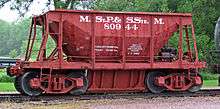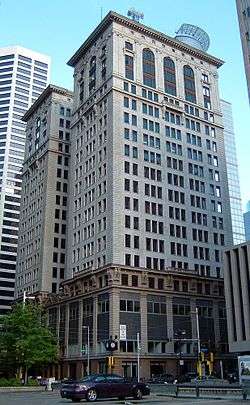Minneapolis, St. Paul and Sault Ste. Marie Railroad
 | |
| Reporting mark | SOO |
|---|---|
| Locale | North Dakota to Chicago |
| Dates of operation | 1883–1961 |
| Successor | Soo Line Railroad |
| Track gauge | 4 ft 8 1⁄2 in (1,435 mm) standard gauge |
| Headquarters | Minneapolis, Minnesota |
The Minneapolis, St. Paul and Sault Ste. Marie Railroad (reporting mark SOO) was a Class I railroad subsidiary of the Canadian Pacific Railway in the Midwest United States. Commonly known since its opening in 1884 as the Soo Line[1] after the phonetic spelling of Sault, it was merged with several other major CP subsidiaries on January 1, 1961, to form the Soo Line Railroad. As time passes, more and more Soo Line equipment is being repainted into the Canadian Pacific's current paint scheme, slowly erasing the Soo's identity as a subsidiary railroad.
In 1970 it reported 8249 million net ton-miles of revenue freight (and no passengers) on 4693 route-miles and 6104 track-miles operated at the end of the year.
Passenger service

The Soo Line was never a major carrier of passenger traffic since its route between Chicago and Minneapolis was much longer than the competing Milwaukee Road, Chicago and North Western and Chicago, Burlington and Quincy Railroad railroads. The Soo Line also had no direct access to Milwaukee.
The primary trains operated by the Soo were:
- The Laker which operated an overnight service from Chicago's Grand Central Station to Duluth–Superior with a portion to Minneapolis–St. Paul. An additional portion served Ashland, Wisconsin, until January 1959. The Laker was discontinued completely on January 15, 1965.
- The Winnipeger which operated overnight between Minneapolis–St. Paul and Winnipeg. It was discontinued in March 1967.[2]
- A Minneapolis–St. Paul to western Canada service. During the 1920s and 1930s the Soo Line operated the Soo-Pacific, a summer-only Chicago to Vancouver service with the Canadian Pacific Railway. This later became The Mountaineer, which was then reduced to Minneapolis–St. Paul to Vancouver, before being discontinued in early August 1960. The Mountaineer was a summer-season-only train that carried exclusively sleeping cars but no coaches.[3] During the non-summer months, the train ran as the Soo-Dominion from Minneapolis–St. Paul to Moose Jaw, Saskatchewan, where it was combined into Canadian Pacific Railway's The Dominion transcontinental passenger train. It was cut back to a St. Paul to Portal run after CP discontinued passenger service to Portal, North Dakota, at the end of 1960,[3] before being discontinued entirely in December 1963.[2]
- A Minneapolis–St. Paul to Sault Ste. Marie, Michigan, overnight train. Discontinued March 1959.
Additionally, local trains served Chicago to Minneapolis–St. Paul, Duluth–Superior to Minneapolis–St. Paul, Duluth to Thief River Falls, Minnesota, and some summer-only services which relieved The Mountaineer of the local work along its route.
Presidents
The Presidents of the Soo Line were:[4]
- William D. Washburn, 1883–1889.
- Thomas Lowry, 1889–1890, 1892–1909.
- F. N. Finney, 1890–1892.
- Edmund Pennington, 1909–1922.
- George Ray Huntington, 1922–1923.
- C. T. Jaffray, 1924–1937.
- G. W. Webster, 1937–1944.
- H. C. Grout, 1944–1949.
- G. Allen MacNamara, 1950–1960.
Timeline

- September 29, 1883: A consortium of flour mill owners in Minneapolis form the Minneapolis, Sault Ste. Marie and Atlantic Railway to build a railroad between its two namesake cities to avoid sending shipments through Chicago.[5][6][7]
- February 23, 1884: The presidents of the Minneapolis, Sault Ste. Marie and Atlantic and the Northern Pacific Railway sign an agreement allowing the MSSM&A to use in perpetuity NP track and facilities in Minneapolis and granting an entry to St. Paul Union Depot.[8] NP's board of directors approved the agreement on March 6.[9]
- March 1884: The first construction contracts are awarded for grading 60 miles of line starting from a point near Turtle Lake.[10] President Washburn receives authorization from the board of directors to place orders for rolling stock.[11]
- November 7, 1884: The ceremonial first train departed Minneapolis to tour from there to Bruce, Wisconsin, the extent of the line that had been constructed so far.[12] On its opening for regular service on November 15,[1] the line measured 46 miles (74 km).[13]
- June 11, 1888: The Canadian Pacific Railway acquires control of the Minneapolis, Sault Ste. Marie and Atlantic Railway, consolidating it with the Minneapolis and Pacific Railway, Minneapolis and St. Croix Railway, and Aberdeen, Bismarck and North Western Railway to form the Minneapolis, St. Paul and Sault Ste. Marie Railway.
- 1904: The Soo Line acquires the Bismarck, Washburn and Great Falls Railway.[14]
- 1908: The Soo Line acquires a majority interest in the Wisconsin Central Railway, and obtains a 99-year lease of the property in 1909.
- 1910: The Soo line acquires the Cuyuna Iron Range Railway.
- 1913: The Soo Line acquires the Minnesota Northwestern Electric Railway and the Fairmount and Veblen Railway.
- 1921: The Soo Line acquires the Wisconsin and Northern Railroad.
- 1932: The Wisconsin Central Railway enters receivership.
- December 31, 1937: The Minneapolis, St. Paul and Sault Ste. Marie Railway files for bankruptcy.
- 1944: The Wisconsin Central Railway enters bankruptcy.
- September 1, 1944: The Soo Line reorganization takes effect, emerging as the Minneapolis, St. Paul and Sault Ste. Marie Railroad.
- 1953: The Valley City Street and Interuban Railway is sold to the Soo Line.
- 1954: The Wisconsin Central emerges from its bankruptcy as the Wisconsin Central Railroad.
- January 1, 1961: The Soo Line Railroad is formed through a merger of the Minneapolis, St. Paul and Sault Ste. Marie Railroad, Wisconsin Central Railroad, and Duluth, South Shore and Atlantic Railroad.
Locomotives
Preservation
A number of the railroad's rolling stock has been preserved in museums across America, some in operational condition. Some of the more notable equipment is:
Steam locomotives
- Soo Line 321 – A restored B class 0-6-0 built in 1887 by Rhode Island Locomotive Works. Later rebuilt as an 0-6-0 tank engine, numbered X-90 and used as a shop switcher. Rebuilt back to a tender engine in preservation.
- Soo Line 346 – A restored B-4 class 0-6-0 built in 1915 by ALCO.
- Soo Line 353 – A restored B-4 class 0-6-0 built in 1920 by ALCO.
- Soo Line 950 – A 2-10-0 locomotive, the only one of its type on the Soo, it is displayed in front of the old Soo Line Depot in Ashland, Wisconsin.
- Soo Line 1003 – A restored 2-8-2 built in 1913 by ALCO.
- Soo Line 2645 – An E-25 class 4-6-0 built by the Brooks Locomotive Works in 1900 for the Wisconsin Central Railway as their No. 247.
- Soo Line 2713 – A restored H-21 class 4-6-2 built in 1913 by ALCO Schenectady. It is located in Veterans Memorial Park in Stevens Point, Wisconsin. With it is Soo Line Caboose 99052, built in 1908 for the Wisconsin Central Railway, their No. 158.
- Soo Line 2714 – A restored H-22 class 4-6-2 built in 1914 by ALCO Schenectady. It is located in Lakeside Park in Fond du Lac, Wisconsin.
- Soo Line 2718 – A restored H-23 class 4-6-2 built in 1923 by ALCO.
- Soo Line 2719 – A restored H-23 class 4-6-2 built in 1923 by ALCO. This locomotive hauled the Soo Line's last steam-powered train in excursion service in 1959.[15]
Diesel locomotives
- Soo 500-A an EMD FP7 displayed at Ladysmith, Wisconsin
- Soo 2500-A an EMD FP-7, at the Lake Superior Railroad Museum, Duluth, Minnesota. Restored for use on their North Shore Scenic Railroad.
References
Notes
- 1 2 "Opening of the "Soo"". Eau Claire News. Eau Claire, WI. November 15, 1884. p. 4 – via Newspapers.com.

- 1 2 Abbey 1984, p. 99.
- 1 2 Abbey 1984, p. 97.
- ↑ Gjevre 1990, pp. 203–207.
- ↑ "Commendation and Wet Blankets". Star Tribune. Minneapolis, MN. August 19, 1883. p. 4 – via Newspapers.com.

- ↑ "A New Railroad in Northern Wisconsin". Chicago Tribune. August 17, 1883. p. 6 – via Newspapers.com.

- ↑ "New Railway Enterprises". Chicago Tribune. October 2, 1883. p. 3 – via Newspapers.com.

- ↑ "The Northern Pacific's Eastern Extension". Chicago Tribune. February 24, 1884. p. 6 – via Newspapers.com.

- ↑ "Minnesota News". The Northern Pacific Farmer. Wadena, MN. March 6, 1884. p. 2 – via Newspapers.com.

- ↑ "(untitled)". Eau Claire Leader. March 5, 1884. p. 4 – via Newspapers.com.

- ↑ "The Sault Ste. Marie Road". Chicago Tribune. March 11, 1884. p. 7 – via Newspapers.com.

- ↑ "A Minneapolis Road - The First Trip Over the Minneapolis and Sault Ste. Marie Railroad". Star Tribune. Minneapolis, MN. November 8, 1884. p. 4 – via Newspapers.com.

- ↑ "Railway Intelligence - Sault Ste Marie". The Gazette. Montreal, Canada. November 13, 1884. p. 1 – via Newspapers.com.

- ↑ Gjevre 1990, p. 19.
- ↑ Gilchinski, Steve (February 1997). pp. 24–25
Bibliography
- Abbey, Wallace W (1984). The Little Jewel. Pueblo, Colorado: Pinon Productions. ISBN 0-930855-00-0. LCCN 84014873.
- Dorin, Patrick C (1979). The Soo Line. Burbank, California: Superior Publishing Company. ISBN 0-87564-712-X. LCCN 79012204.
- Gilchinski, Steve (February 1997). "Soo Line 2-8-2 back in steam". Trains magazine. 57 (2): 24–25.
- Gjevre, John A. (1990) [1973]. Saga of the Soo, west from Shoreham (second ed.). Morehead, Minnesota: Gjevre Books. OCLC 23244801.
External links
| Wikimedia Commons has media related to Soo Line Railroad. |